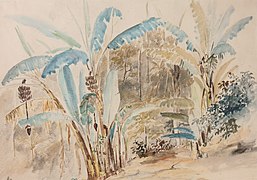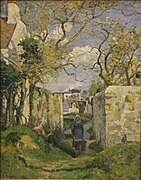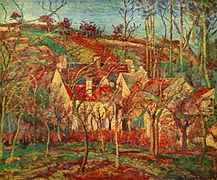Camille Pissarro
Jacob Abraham Camille Pissarro, better known as Camille Pissarro (Saint Thomas, July 10, 1830 – Paris, November 13, 1903), was a painter and French-Danish impressionist engraver.
Considered one of the fathers of Impressionism, Pissarro painted French rural life, specifically landscapes and scenes depicting peasants at work, but also urban scenes in Montmartre. In Paris he had as disciples Paul Cézanne, Paul Gauguin, Jean Peské and Henri-Martin Lamotte; as well as his own son Lucien Pissarro and the American impressionist painter Mary Cassatt.
Pissarro was also a theoretician of anarchy, and he assiduously met the painters of the New Athens who belonged to that movement. He shared that position with Gauguin, with whom he later had a strained relationship.
Biography
Early Years
Camille Pissarro was born on July 10, 1830, on the island of Saint Thomas, in the Virgin Islands archipelago, then a former colonial possession of the kingdom of Denmark in the West Indies, where her parents ran a flourishing manufacturing company. ship parts in the port of Charlotte Amalie. He was the son of Abraham Gabriel Pissarro, a Sephardic Jew of Portuguese origin with French nationality, born in the city of Bordeaux where there was an important community of Portuguese Jews. His mother was the Dominican Rachel Manzano-Pomié, of Spanish descent.
Pissarro, who had completed part of his studies in Paris since 1843, attended Auguste Savary's school, where he learned drawing, watercolours, engraving and techniques to efficiently capture the landscape outdoors. After completing his studies in 1847, he returned to Saint Thomas to work and help in his father's business. In addition, in his spare time on the island he dedicates himself to drawing, although he would later leave home due to his parents' opposition to his vocation as a painter.
Trip to Venezuela
In the middle of the XIX century, in the city of Charlotte Amalie, Pissarro had his first encounter with the Danish painter Fritz Melbye, who will influence the young artist so that he dedicates himself to painting. He soon joins Melbye as an assistant, and at the beginning of 1850 he travels to Hispaniola with his teacher, making drawings and watercolors of the landscapes of Santo Sunday. Months later they return to Saint Thomas, where Melbye begins to organize his first trip to Venezuela, traveling to Caracas, Maiquetía and the plains of the Guárico state, in a journey of approximately a year and a half.
Fritz Melbye once again organizes a second trip to Venezuela, and this time he convinces Pissarro to accompany him and dedicate himself fully to painting. In 1852 Pissarro and his teacher arrived in Venezuela, living between La Guaira and Caracas until 1854, and in that two-year period, carrying out a series of works, observations and notes with light drawing media such as pencil, charcoal, watercolor and ink. China; in them rural and urban landscapes of the surroundings of Caracas, costumbrist scenes and studies of plants and flowers can be appreciated. In these works, Pissaro shows spontaneity and freshness which confirm the plastic skills of the author.
Of these works by Pissarro in Venezuela, about a hundred of them are currently exhibited in the collection of the Museum of Fine Arts in Caracas, 60 in the collection of the National Art Gallery and about 40 in the collection of the Central Bank of Venezuela. In addition, one of these works by Pissarro (Bananeros, 1852) has served as a model for one of Ipostel's stamps on its philatelic sheet, entitled Banco Central de Venezuela. Art Collection.
Pissarro in France
In 1855 he separated from Melbye and moved near Paris, to the town of Passy. There he attended the School of Fine Arts, with a marked academic cut and influenced by the style of painters such as Eugène Delacroix, Charles-François Daubigny and above all Jean-Auguste-Dominique Ingres, where Jean-François Millet marked him for his themes of rural life, for Gustave Courbet and his renunciation of pathos and the picturesque, and for freedom and the poetry of Jean-Baptiste Corot. He worked in the workshop of Anton Melbye, Fritz's older brother. He painted landscapes of the commune of Montmorency.
Between 1859 and 1861, he attended various academies, including that of Father Suisse, where he met Claude Monet, Ludovic Piette, Armand Guillaumin, and Paul Cézanne. In 1863, Cézanne and Émile Zola visited his studio in La Varenne and, in 1865, he spent a period at La Roche-Guyon. He exhibited at the Salons of 1864 and 1865, where he introduced himself as the "student of Melbye and Jean-Baptiste Corot".
Monet and Pissarro met in London, where they met Paul Durand-Ruel, who from then on became the group's official dealer. Pissarro and Monet made studies of buildings shrouded in mist in the English capital.
His style at this time was quite traditional. He is associated with the Barbizon School, although after some time he evolved towards impressionism. He is considered, along with Monet and Alfred Sisley, one of the pure impressionists, differentiating himself from the group of "problems"; (Renoir, Degas, Cezanne).
Returning to France after his stay in London, he fully participated in the exhibitions of the Impressionist group, of which he was a co-founder. In addition, he was the only one along with Berthe Morisot to participate in the eight exhibitions of the group between 1874 and 1886.
During the Franco-Prussian War, in the early 1870s, he returned to England, where he studied English art and especially the landscapes of the British painter Joseph Mallord William Turner. In the 1880s he experimented with pointillism and produced rural scenes of rivers and landscapes, as well as street scenes in Paris, such as Calle Saint-Honoré after noon (1897, Museo Thyssen-Bornemisza, Madrid)., The Hague and London.
Related to his socialist ideas and close to anarchism, he was interested in capturing the work of the peasant and painted French rural life. His scenes from Montmartre are also famous.
As a teacher he had students such as Paul Gauguin, Paul Cézanne, his son Lucien Pissarro and the American impressionist painter Mary Cassatt. Politically he was sympathetic to anarchism.
Gallery
Contenido relacionado
Dario de Regoyos
Fernando Brambila
Jose de Ribera
Janet jackson
Joan Miro





















